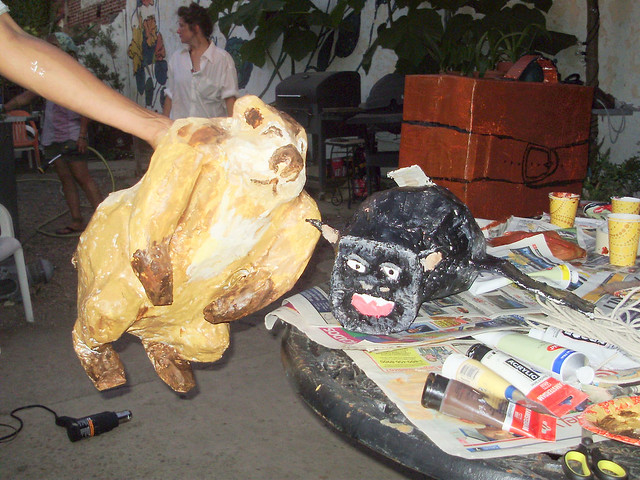Class Report
The Piñata Cycle
What does it mean to create something beautiful and then hit it until it bleeds candy? Do we bash this object apart just for the joyous look (after the carnage) that appears on our friends’ faces as they collect treasures? Or is there a bigger meaning to this ritual? Kate Clark’s two-part class on piñatas during the June 2012 session of Knowledge Commons DC led me to ponder the ephemeral nature of things, and I’d like to share some of what I learned from this class.
I am certain that the hardest part of the piñata cycle for me, as the artist, is the destruction. I still cannot bring myself to break my ferocious bat piñata I spent hours creating. My piñata sits in my dining room and stares at me with its big animal-eyes. My housemate calls the piñata the totem of our group house; it has become both an emblem for the house and a part of the family. I know one day I will have to wallop it with gusto, out of respect for the piñata cycle (see below).
Piñata Cycle:
1. Sketch out design.
2. Create base out of cardboard and masking tape.
3. Papier-mâché.
4. Paint.
5. Add goodies.
6. DESTROY!
7. Repeat.

I will now relate the sad story of how Mother Nature reminded Knowledge Commons students about step 6 in the cycle and preempted step 5. My classmate had the inspired idea to make a groundhog piñata for the community garden where she works. And, as a side note, the groundhog and my bat became instant friends (see photo.) She intended to use her groundhog piñata to scare off real groundhogs that had been attacking her vegetables. These animals had not been deterred by traps or scarecrows, and she thought that if they saw gardeners destroy a fake groundhog, it would give the groundhog colony pause.
Sonia Booth is a museum educator who grew up in the Boston area. She works as a program coordinator at the U.S. Holocaust Memorial Museum. Before she moved to DC she gave tours of the Boston Massacre site for the Old State House Museum in Massachusetts. As part of the Knowledge Commons DC organizing team, she helps wrangle volunteers, facilitators, and classes. Her favorite fruit is cherimoya.
